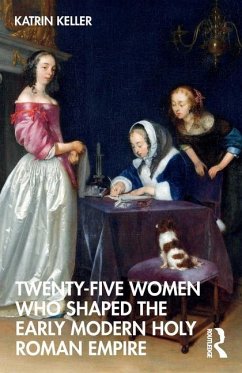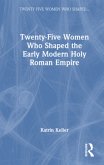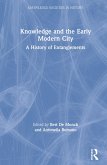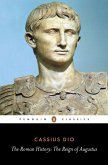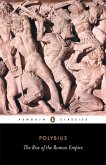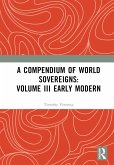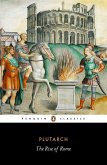Katrin Keller
Twenty-Five Women Who Shaped the Early Modern Holy Roman Empire
Katrin Keller
Twenty-Five Women Who Shaped the Early Modern Holy Roman Empire
- Broschiertes Buch
- Merkliste
- Auf die Merkliste
- Bewerten Bewerten
- Teilen
- Produkt teilen
- Produkterinnerung
- Produkterinnerung
Challenging the conception that only men shaped the Holy Roman Empire, this book provides students and general readers with biographies of preachers, nuns, princesses, businesswomen, artists scientists, writers and social movers who exercised agency in the Holy Roman Empire.
Andere Kunden interessierten sich auch für
![Twenty-Five Women Who Shaped the Early Modern Holy Roman Empire Twenty-Five Women Who Shaped the Early Modern Holy Roman Empire]() Katrin KellerTwenty-Five Women Who Shaped the Early Modern Holy Roman Empire118,99 €
Katrin KellerTwenty-Five Women Who Shaped the Early Modern Holy Roman Empire118,99 €![Knowledge and the Early Modern City Knowledge and the Early Modern City]() Knowledge and the Early Modern City40,99 €
Knowledge and the Early Modern City40,99 €![The Roman History The Roman History]() Cassius DioThe Roman History16,99 €
Cassius DioThe Roman History16,99 €![Voices from the Italian Renaissance Voices from the Italian Renaissance]() Lisa KaborychaVoices from the Italian Renaissance50,99 €
Lisa KaborychaVoices from the Italian Renaissance50,99 €![The Rise of the Roman Empire The Rise of the Roman Empire]() PolybiusThe Rise of the Roman Empire18,99 €
PolybiusThe Rise of the Roman Empire18,99 €![A Compendium of World Sovereigns A Compendium of World Sovereigns]() A Compendium of World Sovereigns115,99 €
A Compendium of World Sovereigns115,99 €![The Rise of Rome The Rise of Rome]() PlutarchThe Rise of Rome22,99 €
PlutarchThe Rise of Rome22,99 €-
-
-
Challenging the conception that only men shaped the Holy Roman Empire, this book provides students and general readers with biographies of preachers, nuns, princesses, businesswomen, artists scientists, writers and social movers who exercised agency in the Holy Roman Empire.
Hinweis: Dieser Artikel kann nur an eine deutsche Lieferadresse ausgeliefert werden.
Hinweis: Dieser Artikel kann nur an eine deutsche Lieferadresse ausgeliefert werden.
Produktdetails
- Produktdetails
- Twenty Five Women Who Shaped the...
- Verlag: Taylor & Francis Ltd
- Seitenzahl: 330
- Erscheinungstermin: 25. Juli 2024
- Englisch
- Abmessung: 198mm x 129mm x 18mm
- Gewicht: 352g
- ISBN-13: 9781032181059
- ISBN-10: 1032181052
- Artikelnr.: 70149479
- Herstellerkennzeichnung
- Books on Demand GmbH
- In de Tarpen 42
- 22848 Norderstedt
- info@bod.de
- 040 53433511
- Twenty Five Women Who Shaped the...
- Verlag: Taylor & Francis Ltd
- Seitenzahl: 330
- Erscheinungstermin: 25. Juli 2024
- Englisch
- Abmessung: 198mm x 129mm x 18mm
- Gewicht: 352g
- ISBN-13: 9781032181059
- ISBN-10: 1032181052
- Artikelnr.: 70149479
- Herstellerkennzeichnung
- Books on Demand GmbH
- In de Tarpen 42
- 22848 Norderstedt
- info@bod.de
- 040 53433511
Katrin Keller is Director of the Institute for Habsburg and Balkan Studies of the Austrian Academy of Sciences, Austria.
1. Introduction
The Sixteenth Century: Preachers, Nuns, and Dynastic Women
2. Caritas Pirckheimer (1467-1532): The Learned Nun
3. Katharina Zell (1497/98-1562): A Woman who Preached
4. Maria of Hungary (1505-1558): On Behalf of the Dynasty
5. Elisabeth of Brunswick-Calenberg (1510-1558): A Princess as Reformer
6. Anna of Saxony (1532-1585): Of Princely Domains and Good Medicines
7. Archduchess Maria of Inner Austria (1551-1608): How a Mother Shapes her
Children
The Seventeenth Century: Princesses, Businesswomen, and Artists
8. Polyxena of Lobkowicz (1566-1642): Between Bohemia and Spain
9. Anna of Brandenburg (1576-1625): How Prussia came to Brandenburg
10. Maria Magdalena Haidenbucher (1576-1650): Abbess in Troubled Times
11. Catharina Regina von Greiffenberg (1633-1694): The Poet in Exile
12. Maria Sibylla Merian (1647-1717): Science and Painting
13. Glikl bas Judah Leib (1647?-1724): The Experiences of a Jewish
Businesswoman
14. Empress Eleonora Magdalena (1655-1720): How to Care for Your Siblings
15. Maria Aurora von Königsmarck (1662-1728): The Mistress in the Imperial
Abbey
The Eighteenth Century: Scientists, Writers, and Social Movers
16. Erdmuthe Benigna of Reuß-Ebersdorf (1670-1732): Women and the Pietist
Movement
17. Maria Margaretha Kirch (1670-1720): The Arduous Journey to the Sciences
18. Luise Adelgunde Gottsched (1713-1762): More than the Woman at his Side
19. Dorothea Erxleben (1715-1762): A Medical Doctor Prevails
20. Empress Maria Theresa (1717-1780): The Heiress
21. Anna Dorothea Therbusch (1721-1782): From Innkeeper to Court Painter
22. Anna Barbara Gignoux (1725-1796): How to Defend a Calico Manufactory
23. Sophie von La Roche (1730-1807): A Life as a Female Author
24. Amalie Gallitzin (1748-1806): Philosophy, Religion, and Conviviality
25. Maria Theresia Paradis (1759-1824): The Blind Pianist
26.Henriette Herz (1764-1847): A Salon in Berlin
The Sixteenth Century: Preachers, Nuns, and Dynastic Women
2. Caritas Pirckheimer (1467-1532): The Learned Nun
3. Katharina Zell (1497/98-1562): A Woman who Preached
4. Maria of Hungary (1505-1558): On Behalf of the Dynasty
5. Elisabeth of Brunswick-Calenberg (1510-1558): A Princess as Reformer
6. Anna of Saxony (1532-1585): Of Princely Domains and Good Medicines
7. Archduchess Maria of Inner Austria (1551-1608): How a Mother Shapes her
Children
The Seventeenth Century: Princesses, Businesswomen, and Artists
8. Polyxena of Lobkowicz (1566-1642): Between Bohemia and Spain
9. Anna of Brandenburg (1576-1625): How Prussia came to Brandenburg
10. Maria Magdalena Haidenbucher (1576-1650): Abbess in Troubled Times
11. Catharina Regina von Greiffenberg (1633-1694): The Poet in Exile
12. Maria Sibylla Merian (1647-1717): Science and Painting
13. Glikl bas Judah Leib (1647?-1724): The Experiences of a Jewish
Businesswoman
14. Empress Eleonora Magdalena (1655-1720): How to Care for Your Siblings
15. Maria Aurora von Königsmarck (1662-1728): The Mistress in the Imperial
Abbey
The Eighteenth Century: Scientists, Writers, and Social Movers
16. Erdmuthe Benigna of Reuß-Ebersdorf (1670-1732): Women and the Pietist
Movement
17. Maria Margaretha Kirch (1670-1720): The Arduous Journey to the Sciences
18. Luise Adelgunde Gottsched (1713-1762): More than the Woman at his Side
19. Dorothea Erxleben (1715-1762): A Medical Doctor Prevails
20. Empress Maria Theresa (1717-1780): The Heiress
21. Anna Dorothea Therbusch (1721-1782): From Innkeeper to Court Painter
22. Anna Barbara Gignoux (1725-1796): How to Defend a Calico Manufactory
23. Sophie von La Roche (1730-1807): A Life as a Female Author
24. Amalie Gallitzin (1748-1806): Philosophy, Religion, and Conviviality
25. Maria Theresia Paradis (1759-1824): The Blind Pianist
26.Henriette Herz (1764-1847): A Salon in Berlin
1. Introduction
The Sixteenth Century: Preachers, Nuns, and Dynastic Women
2. Caritas Pirckheimer (1467-1532): The Learned Nun
3. Katharina Zell (1497/98-1562): A Woman who Preached
4. Maria of Hungary (1505-1558): On Behalf of the Dynasty
5. Elisabeth of Brunswick-Calenberg (1510-1558): A Princess as Reformer
6. Anna of Saxony (1532-1585): Of Princely Domains and Good Medicines
7. Archduchess Maria of Inner Austria (1551-1608): How a Mother Shapes her Children
The Seventeenth Century: Princesses, Businesswomen, and Artists
8. Polyxena of Lobkowicz (1566-1642): Between Bohemia and Spain
9. Anna of Brandenburg (1576-1625): How Prussia came to Brandenburg
10. Maria Magdalena Haidenbucher (1576-1650): Abbess in Troubled Times
11. Catharina Regina von Greiffenberg (1633-1694): The Poet in Exile
12. Maria Sibylla Merian (1647-1717): Science and Painting
13. Glikl bas Judah Leib (1647?-1724): The Experiences of a Jewish Businesswoman
14. Empress Eleonora Magdalena (1655-1720): How to Care for Your Siblings
15. Maria Aurora von Königsmarck (1662-1728): The Mistress in the Imperial Abbey
The Eighteenth Century: Scientists, Writers, and Social Movers
16. Erdmuthe Benigna of Reuß-Ebersdorf (1670-1732): Women and the Pietist Movement
17. Maria Margaretha Kirch (1670-1720): The Arduous Journey to the Sciences
18. Luise Adelgunde Gottsched (1713-1762): More than the Woman at his Side
19. Dorothea Erxleben (1715-1762): A Medical Doctor Prevails
20. Empress Maria Theresa (1717-1780): The Heiress
21. Anna Dorothea Therbusch (1721-1782): From Innkeeper to Court Painter
22. Anna Barbara Gignoux (1725-1796): How to Defend a Calico Manufactory
23. Sophie von La Roche (1730-1807): A Life as a Female Author
24. Amalie Gallitzin (1748-1806): Philosophy, Religion, and Conviviality
25. Maria Theresia Paradis (1759-1824): The Blind Pianist
26.Henriette Herz (1764-1847): A Salon in Berlin
The Sixteenth Century: Preachers, Nuns, and Dynastic Women
2. Caritas Pirckheimer (1467-1532): The Learned Nun
3. Katharina Zell (1497/98-1562): A Woman who Preached
4. Maria of Hungary (1505-1558): On Behalf of the Dynasty
5. Elisabeth of Brunswick-Calenberg (1510-1558): A Princess as Reformer
6. Anna of Saxony (1532-1585): Of Princely Domains and Good Medicines
7. Archduchess Maria of Inner Austria (1551-1608): How a Mother Shapes her Children
The Seventeenth Century: Princesses, Businesswomen, and Artists
8. Polyxena of Lobkowicz (1566-1642): Between Bohemia and Spain
9. Anna of Brandenburg (1576-1625): How Prussia came to Brandenburg
10. Maria Magdalena Haidenbucher (1576-1650): Abbess in Troubled Times
11. Catharina Regina von Greiffenberg (1633-1694): The Poet in Exile
12. Maria Sibylla Merian (1647-1717): Science and Painting
13. Glikl bas Judah Leib (1647?-1724): The Experiences of a Jewish Businesswoman
14. Empress Eleonora Magdalena (1655-1720): How to Care for Your Siblings
15. Maria Aurora von Königsmarck (1662-1728): The Mistress in the Imperial Abbey
The Eighteenth Century: Scientists, Writers, and Social Movers
16. Erdmuthe Benigna of Reuß-Ebersdorf (1670-1732): Women and the Pietist Movement
17. Maria Margaretha Kirch (1670-1720): The Arduous Journey to the Sciences
18. Luise Adelgunde Gottsched (1713-1762): More than the Woman at his Side
19. Dorothea Erxleben (1715-1762): A Medical Doctor Prevails
20. Empress Maria Theresa (1717-1780): The Heiress
21. Anna Dorothea Therbusch (1721-1782): From Innkeeper to Court Painter
22. Anna Barbara Gignoux (1725-1796): How to Defend a Calico Manufactory
23. Sophie von La Roche (1730-1807): A Life as a Female Author
24. Amalie Gallitzin (1748-1806): Philosophy, Religion, and Conviviality
25. Maria Theresia Paradis (1759-1824): The Blind Pianist
26.Henriette Herz (1764-1847): A Salon in Berlin
1. Introduction
The Sixteenth Century: Preachers, Nuns, and Dynastic Women
2. Caritas Pirckheimer (1467-1532): The Learned Nun
3. Katharina Zell (1497/98-1562): A Woman who Preached
4. Maria of Hungary (1505-1558): On Behalf of the Dynasty
5. Elisabeth of Brunswick-Calenberg (1510-1558): A Princess as Reformer
6. Anna of Saxony (1532-1585): Of Princely Domains and Good Medicines
7. Archduchess Maria of Inner Austria (1551-1608): How a Mother Shapes her
Children
The Seventeenth Century: Princesses, Businesswomen, and Artists
8. Polyxena of Lobkowicz (1566-1642): Between Bohemia and Spain
9. Anna of Brandenburg (1576-1625): How Prussia came to Brandenburg
10. Maria Magdalena Haidenbucher (1576-1650): Abbess in Troubled Times
11. Catharina Regina von Greiffenberg (1633-1694): The Poet in Exile
12. Maria Sibylla Merian (1647-1717): Science and Painting
13. Glikl bas Judah Leib (1647?-1724): The Experiences of a Jewish
Businesswoman
14. Empress Eleonora Magdalena (1655-1720): How to Care for Your Siblings
15. Maria Aurora von Königsmarck (1662-1728): The Mistress in the Imperial
Abbey
The Eighteenth Century: Scientists, Writers, and Social Movers
16. Erdmuthe Benigna of Reuß-Ebersdorf (1670-1732): Women and the Pietist
Movement
17. Maria Margaretha Kirch (1670-1720): The Arduous Journey to the Sciences
18. Luise Adelgunde Gottsched (1713-1762): More than the Woman at his Side
19. Dorothea Erxleben (1715-1762): A Medical Doctor Prevails
20. Empress Maria Theresa (1717-1780): The Heiress
21. Anna Dorothea Therbusch (1721-1782): From Innkeeper to Court Painter
22. Anna Barbara Gignoux (1725-1796): How to Defend a Calico Manufactory
23. Sophie von La Roche (1730-1807): A Life as a Female Author
24. Amalie Gallitzin (1748-1806): Philosophy, Religion, and Conviviality
25. Maria Theresia Paradis (1759-1824): The Blind Pianist
26.Henriette Herz (1764-1847): A Salon in Berlin
The Sixteenth Century: Preachers, Nuns, and Dynastic Women
2. Caritas Pirckheimer (1467-1532): The Learned Nun
3. Katharina Zell (1497/98-1562): A Woman who Preached
4. Maria of Hungary (1505-1558): On Behalf of the Dynasty
5. Elisabeth of Brunswick-Calenberg (1510-1558): A Princess as Reformer
6. Anna of Saxony (1532-1585): Of Princely Domains and Good Medicines
7. Archduchess Maria of Inner Austria (1551-1608): How a Mother Shapes her
Children
The Seventeenth Century: Princesses, Businesswomen, and Artists
8. Polyxena of Lobkowicz (1566-1642): Between Bohemia and Spain
9. Anna of Brandenburg (1576-1625): How Prussia came to Brandenburg
10. Maria Magdalena Haidenbucher (1576-1650): Abbess in Troubled Times
11. Catharina Regina von Greiffenberg (1633-1694): The Poet in Exile
12. Maria Sibylla Merian (1647-1717): Science and Painting
13. Glikl bas Judah Leib (1647?-1724): The Experiences of a Jewish
Businesswoman
14. Empress Eleonora Magdalena (1655-1720): How to Care for Your Siblings
15. Maria Aurora von Königsmarck (1662-1728): The Mistress in the Imperial
Abbey
The Eighteenth Century: Scientists, Writers, and Social Movers
16. Erdmuthe Benigna of Reuß-Ebersdorf (1670-1732): Women and the Pietist
Movement
17. Maria Margaretha Kirch (1670-1720): The Arduous Journey to the Sciences
18. Luise Adelgunde Gottsched (1713-1762): More than the Woman at his Side
19. Dorothea Erxleben (1715-1762): A Medical Doctor Prevails
20. Empress Maria Theresa (1717-1780): The Heiress
21. Anna Dorothea Therbusch (1721-1782): From Innkeeper to Court Painter
22. Anna Barbara Gignoux (1725-1796): How to Defend a Calico Manufactory
23. Sophie von La Roche (1730-1807): A Life as a Female Author
24. Amalie Gallitzin (1748-1806): Philosophy, Religion, and Conviviality
25. Maria Theresia Paradis (1759-1824): The Blind Pianist
26.Henriette Herz (1764-1847): A Salon in Berlin
1. Introduction
The Sixteenth Century: Preachers, Nuns, and Dynastic Women
2. Caritas Pirckheimer (1467-1532): The Learned Nun
3. Katharina Zell (1497/98-1562): A Woman who Preached
4. Maria of Hungary (1505-1558): On Behalf of the Dynasty
5. Elisabeth of Brunswick-Calenberg (1510-1558): A Princess as Reformer
6. Anna of Saxony (1532-1585): Of Princely Domains and Good Medicines
7. Archduchess Maria of Inner Austria (1551-1608): How a Mother Shapes her Children
The Seventeenth Century: Princesses, Businesswomen, and Artists
8. Polyxena of Lobkowicz (1566-1642): Between Bohemia and Spain
9. Anna of Brandenburg (1576-1625): How Prussia came to Brandenburg
10. Maria Magdalena Haidenbucher (1576-1650): Abbess in Troubled Times
11. Catharina Regina von Greiffenberg (1633-1694): The Poet in Exile
12. Maria Sibylla Merian (1647-1717): Science and Painting
13. Glikl bas Judah Leib (1647?-1724): The Experiences of a Jewish Businesswoman
14. Empress Eleonora Magdalena (1655-1720): How to Care for Your Siblings
15. Maria Aurora von Königsmarck (1662-1728): The Mistress in the Imperial Abbey
The Eighteenth Century: Scientists, Writers, and Social Movers
16. Erdmuthe Benigna of Reuß-Ebersdorf (1670-1732): Women and the Pietist Movement
17. Maria Margaretha Kirch (1670-1720): The Arduous Journey to the Sciences
18. Luise Adelgunde Gottsched (1713-1762): More than the Woman at his Side
19. Dorothea Erxleben (1715-1762): A Medical Doctor Prevails
20. Empress Maria Theresa (1717-1780): The Heiress
21. Anna Dorothea Therbusch (1721-1782): From Innkeeper to Court Painter
22. Anna Barbara Gignoux (1725-1796): How to Defend a Calico Manufactory
23. Sophie von La Roche (1730-1807): A Life as a Female Author
24. Amalie Gallitzin (1748-1806): Philosophy, Religion, and Conviviality
25. Maria Theresia Paradis (1759-1824): The Blind Pianist
26.Henriette Herz (1764-1847): A Salon in Berlin
The Sixteenth Century: Preachers, Nuns, and Dynastic Women
2. Caritas Pirckheimer (1467-1532): The Learned Nun
3. Katharina Zell (1497/98-1562): A Woman who Preached
4. Maria of Hungary (1505-1558): On Behalf of the Dynasty
5. Elisabeth of Brunswick-Calenberg (1510-1558): A Princess as Reformer
6. Anna of Saxony (1532-1585): Of Princely Domains and Good Medicines
7. Archduchess Maria of Inner Austria (1551-1608): How a Mother Shapes her Children
The Seventeenth Century: Princesses, Businesswomen, and Artists
8. Polyxena of Lobkowicz (1566-1642): Between Bohemia and Spain
9. Anna of Brandenburg (1576-1625): How Prussia came to Brandenburg
10. Maria Magdalena Haidenbucher (1576-1650): Abbess in Troubled Times
11. Catharina Regina von Greiffenberg (1633-1694): The Poet in Exile
12. Maria Sibylla Merian (1647-1717): Science and Painting
13. Glikl bas Judah Leib (1647?-1724): The Experiences of a Jewish Businesswoman
14. Empress Eleonora Magdalena (1655-1720): How to Care for Your Siblings
15. Maria Aurora von Königsmarck (1662-1728): The Mistress in the Imperial Abbey
The Eighteenth Century: Scientists, Writers, and Social Movers
16. Erdmuthe Benigna of Reuß-Ebersdorf (1670-1732): Women and the Pietist Movement
17. Maria Margaretha Kirch (1670-1720): The Arduous Journey to the Sciences
18. Luise Adelgunde Gottsched (1713-1762): More than the Woman at his Side
19. Dorothea Erxleben (1715-1762): A Medical Doctor Prevails
20. Empress Maria Theresa (1717-1780): The Heiress
21. Anna Dorothea Therbusch (1721-1782): From Innkeeper to Court Painter
22. Anna Barbara Gignoux (1725-1796): How to Defend a Calico Manufactory
23. Sophie von La Roche (1730-1807): A Life as a Female Author
24. Amalie Gallitzin (1748-1806): Philosophy, Religion, and Conviviality
25. Maria Theresia Paradis (1759-1824): The Blind Pianist
26.Henriette Herz (1764-1847): A Salon in Berlin
"Through her well-chosen examples, Katrin Keller unlocks a multitude of previously hidden or partially obscured connections across the last three centuries of the vast Holy Roman Empire's existence, revealing not only how this complex entity functioned, but the important contributions made by women to its artistic, cultural, dynastic, economic, medical, political, religious, and scientific history. Fascinating and absorbing."
Peter H. Wilson, University of Oxford, UK
Peter H. Wilson, University of Oxford, UK

